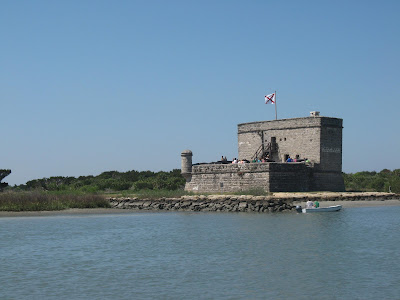To continue celebrating National Parks Week, I've chosen Fort Matanzas-- a fan favorite in my family. For us, the fort is not only hidden away in an area surrounded by a lovely nature walk, picnic tables, oaks trees begging to be climbed. In addition to all these fabulous things, visiting Fort Matanzas requires a short boat ride across the Matanzas Inlet with an all access pass to explore the "baby" fort's history.
 |
| View of Fort Matanzas on the boat ride across the inlet. |
Two hundred years before the fort was constructed, the inlet witnessed a mass slaughter of Frenchmen. In August of 1565, French and Spanish forces reached Florida's northeastern coast. The French presence posed a threat to Spanish settlement. Enraged by the French action, and their Protestant beliefs, the Spanish Crown enlisted Pedro Menéndez de Aviles to remove the French from Florida. An untimely hurricane wrecked French ships, and the reinforcements, south of Daytona Beach. Menéndez proceeded to attack Fort Caroline at the same time. Weakened by the missing troops, Menéndez defeated the resistance and took the lives of most troops at Fort Caroline. Within the next few weeks, the Frenchmen who were shipwrecked during the storm began to appear as they sought Fort Caroline. Menéndez intercepted two different groups at the inlet. Here, Menéndez demanded the French renounce their Protestant faith and adopt Catholicism or accept death. True to their faith, most men denied Catholicism, electing death instead. These bloody encounters are the source for the name Matanzas, which means slaughter, Inlet.
 |
| Why my family nicknamed Fort Matanzas the "baby" fort. |
The Spanish recognized the need for a defensive post along the inlet. Before the fort, a watchtower guarded St. Augustine's back entrance. Repeated attacks showed that the area required more permanent protective measures. Spanish troops began constructing the coquina fort in the fall of 1740. Completed by September 1942, Fort Matanzas withstood multiple planned attacks.
Over time, the fort fell into disrepair. No longer necessary to fortify St. Augustine, Fort Matanzas was considered to possess only historical value. Fortunately wealthy visitors successfully encouraged Congress to preserve both Fort Matanzas and the Castillo (called Fort Marion at that time) in 1916.
 |
| Yours truly, wedging herself through the hole to the upper deck of the fort-- a worthwhile experience. |
I consider Fort Matanzas a gem hidden among the beautiful scenery of
A1A's Scenic Byway, the ocean, and the inlet. Get out there and enjoy the sun, the fresh, salted air, the immense history of the Fort! Perhaps you, too, will see the young owl fledglings while visiting. After all, National Parks are free this week. What better time is there to visit?
 |
| The owlets currently at the park. |
For more information about the fort's history and other amazing attributes, visit the
NPS website.





